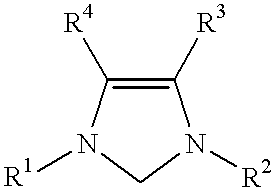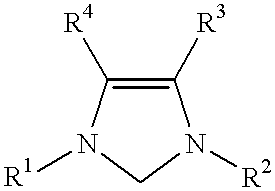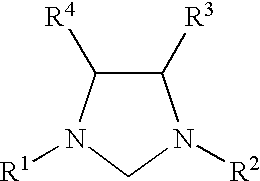Use of catalyst system comprising nickel, palladium, or platinum and imidazoline-2-ylidene or imidazolidine-2-ylidene in amination reactions
a catalyst system and catalyst technology, applied in the direction of catalytic reactions, group 3/13 element organic compounds, group 5/15 element organic compounds, etc., can solve the problems of inability to employ aryl chlorides as feedstock for chemical transformation, requiring the use of more expensive aryl bromides and aryl iodides, and achieving good yield
- Summary
- Abstract
- Description
- Claims
- Application Information
AI Technical Summary
Benefits of technology
Problems solved by technology
Method used
Image
Examples
example 1
For each run, a Schlenk tube was charged with Pd.sub.2 (dibenzylideneacetone).sub.3 (10 mg, 0.01 mmol), 1,3-bis(substituted)imidazolinium chloride (0.04 mmol), and a magnetic stirring bar. After a 30 minute catalyst activation period, 1,4-dioxane (3 mL), KOtBu (168 mg, 1.5 mmol), 4-chlorotoluene (1.0 mmol), and N-methylaniline (1.2 mmol) were added in turn to the Schlenk tube. The Schlenk tube was placed in a 100.degree. C. oil bath and the mixture was stirred for 3 hours. The mixture was then allowed to cool to room temperature. The mixture was washed with diethyl ether. The organic layer and the diethyl ether extracts were combined, washed with saturated saline solution, and then dried over MgSO.sub.4. The solvent was removed under vacuum and the residue was purified by flash chromatography using hexane or a mixture of hexane and ethyl acetate.
The 1,3-bis(substituted)imidazolinium chloride used in each run are listed in Table 1. All of the yields reported in Table 1 are of the het...
example 2
Reagents, analyses, and procedures were as described in Example 1, except as follows. The 1,3-bis(substituted)imidazolinium chloride used in all runs was 1,3-Bis(2,6-diisopropylphenyl)imidazolinium chloride. Several different aryl chlorides (1.0 mmol each) and amines (1.2 mmol each) were used. Reactions were complete in three to thirty hours, but reaction times have not been optimized.
The aryl chlorides and amines used in each run are listed in Table 2;. All of the yields reported in Table 2 are of the heterocoupling product, and are the average of two runs.
example 3
Reagents, analyses, and procedures were as described in Example 1, except as follows. The 1,3-bis(substituted)imidazolinium chloride used in all runs was 1,3-Bis(2,6-diisopropylphenyl) imidazolinium chloride. Several different aryl halides (1.0 mmol each) and amines (1.2 mmol each) were used. Reactions were complete in three to thirty hours, but reaction times have not been optimized.
The aryl halides and amines used in each run are listed in Table 3. All of the yields reported in Table 3 are of the heterocoupling product, and are the average of two runs.
PUM
| Property | Measurement | Unit |
|---|---|---|
| Angle | aaaaa | aaaaa |
| Angle | aaaaa | aaaaa |
| Fraction | aaaaa | aaaaa |
Abstract
Description
Claims
Application Information
 Login to View More
Login to View More - R&D
- Intellectual Property
- Life Sciences
- Materials
- Tech Scout
- Unparalleled Data Quality
- Higher Quality Content
- 60% Fewer Hallucinations
Browse by: Latest US Patents, China's latest patents, Technical Efficacy Thesaurus, Application Domain, Technology Topic, Popular Technical Reports.
© 2025 PatSnap. All rights reserved.Legal|Privacy policy|Modern Slavery Act Transparency Statement|Sitemap|About US| Contact US: help@patsnap.com



